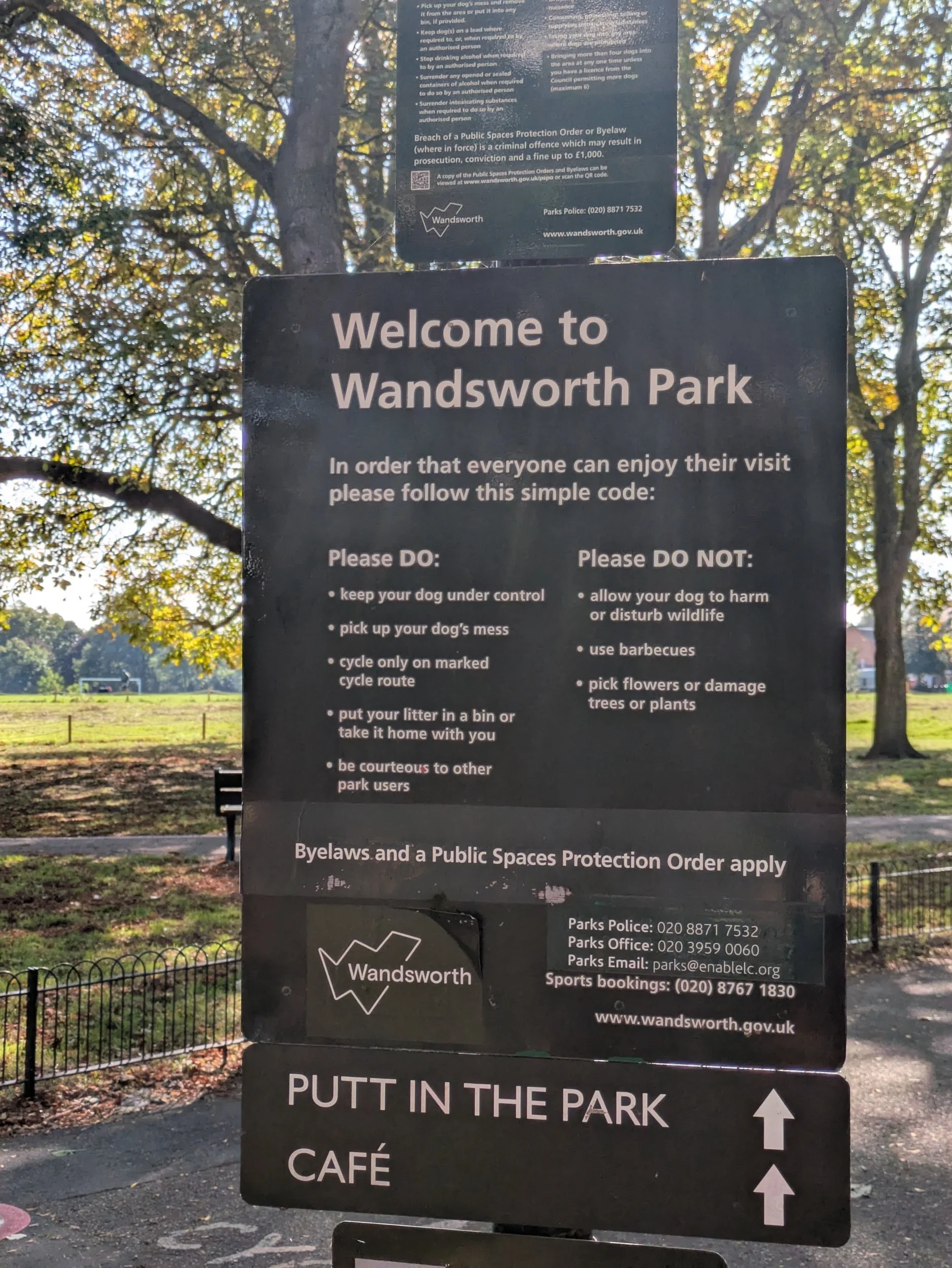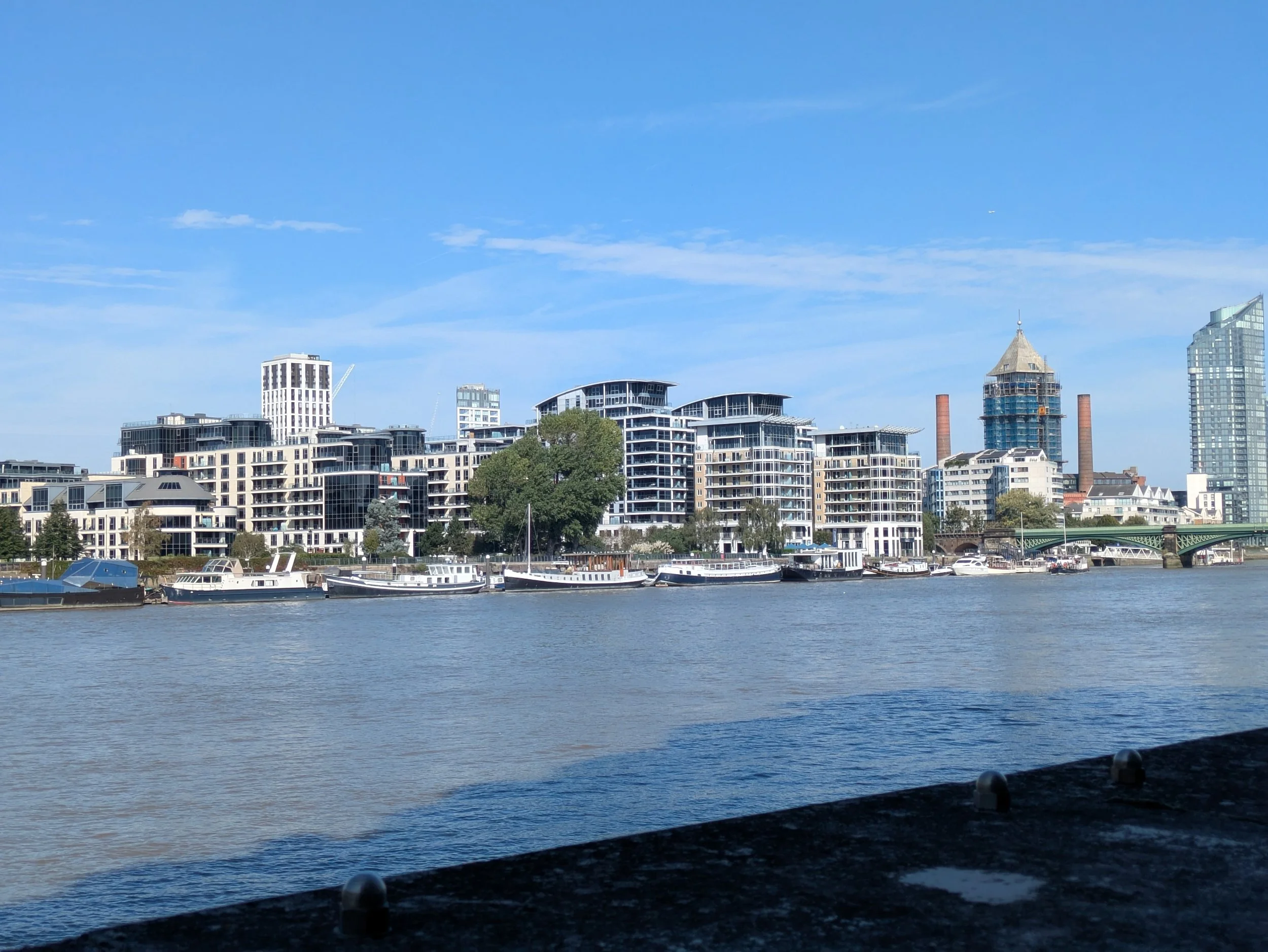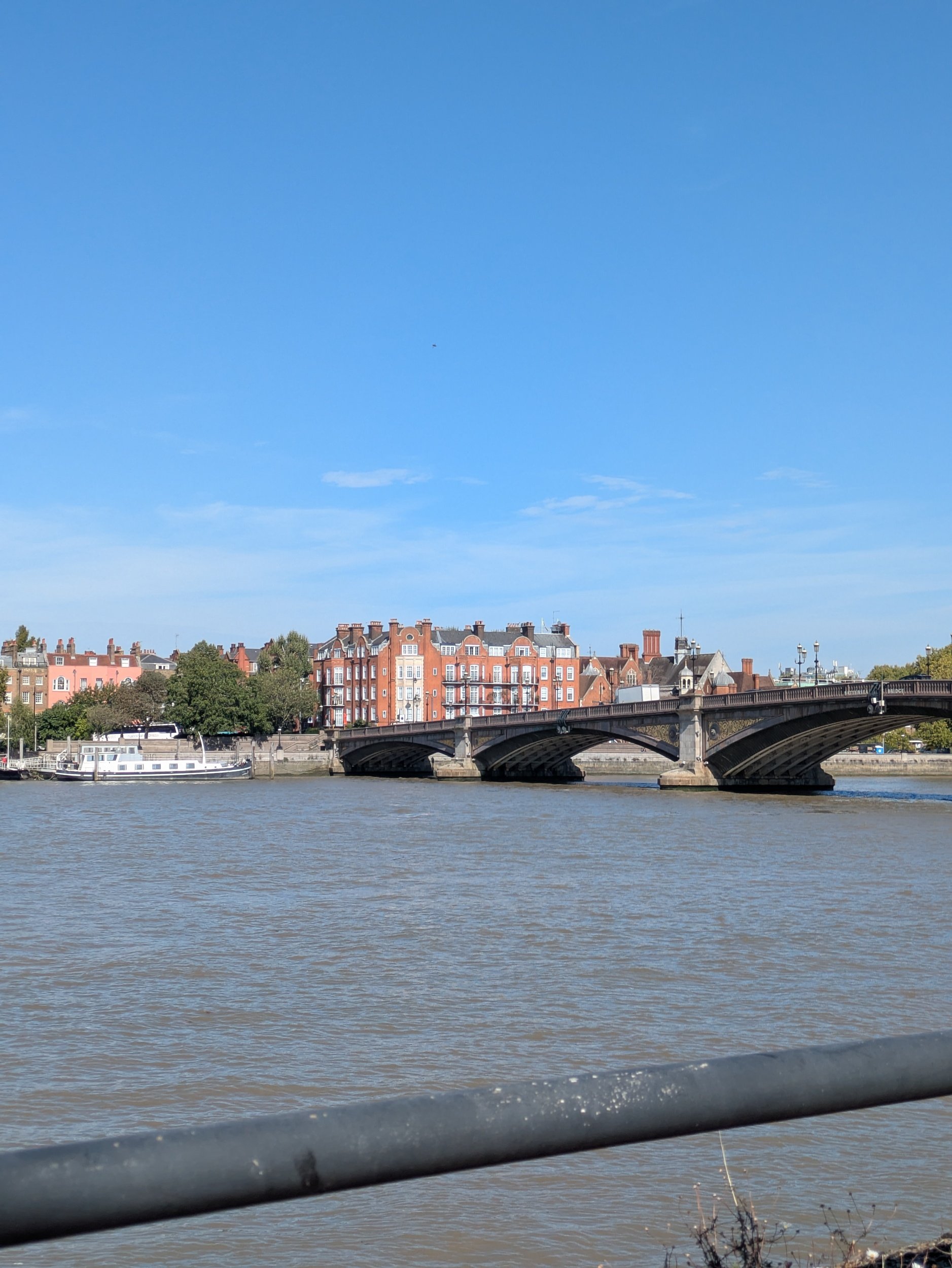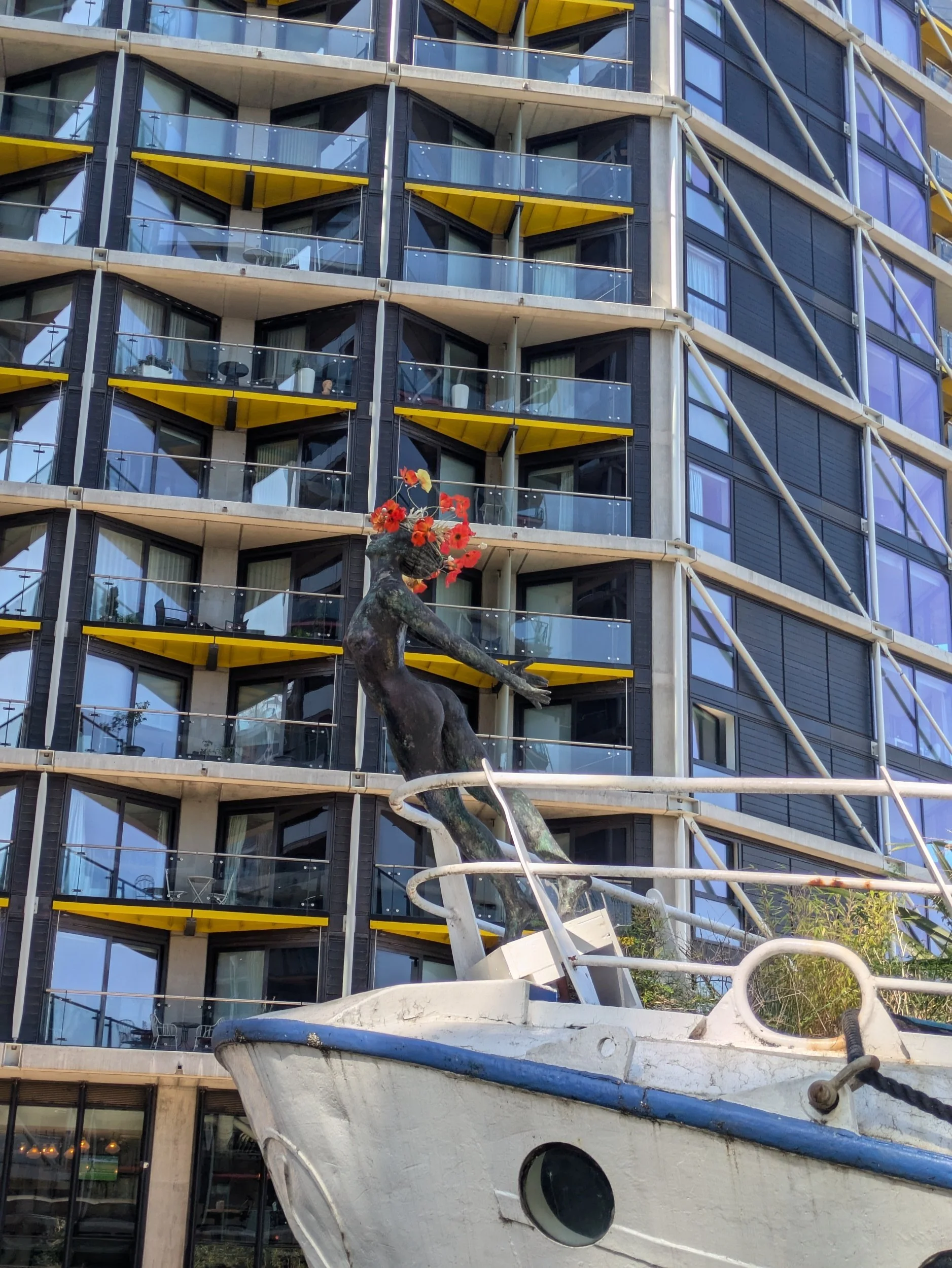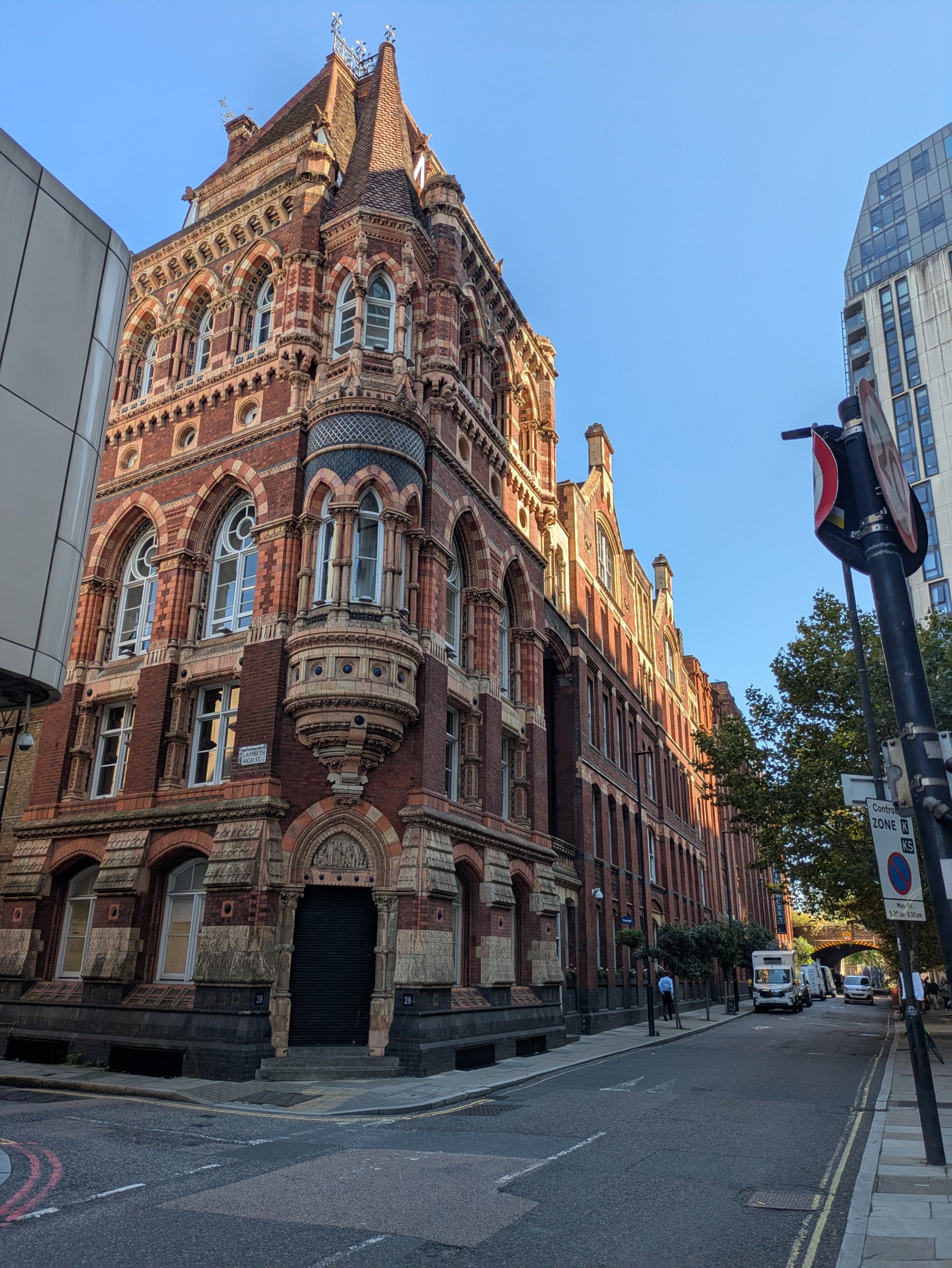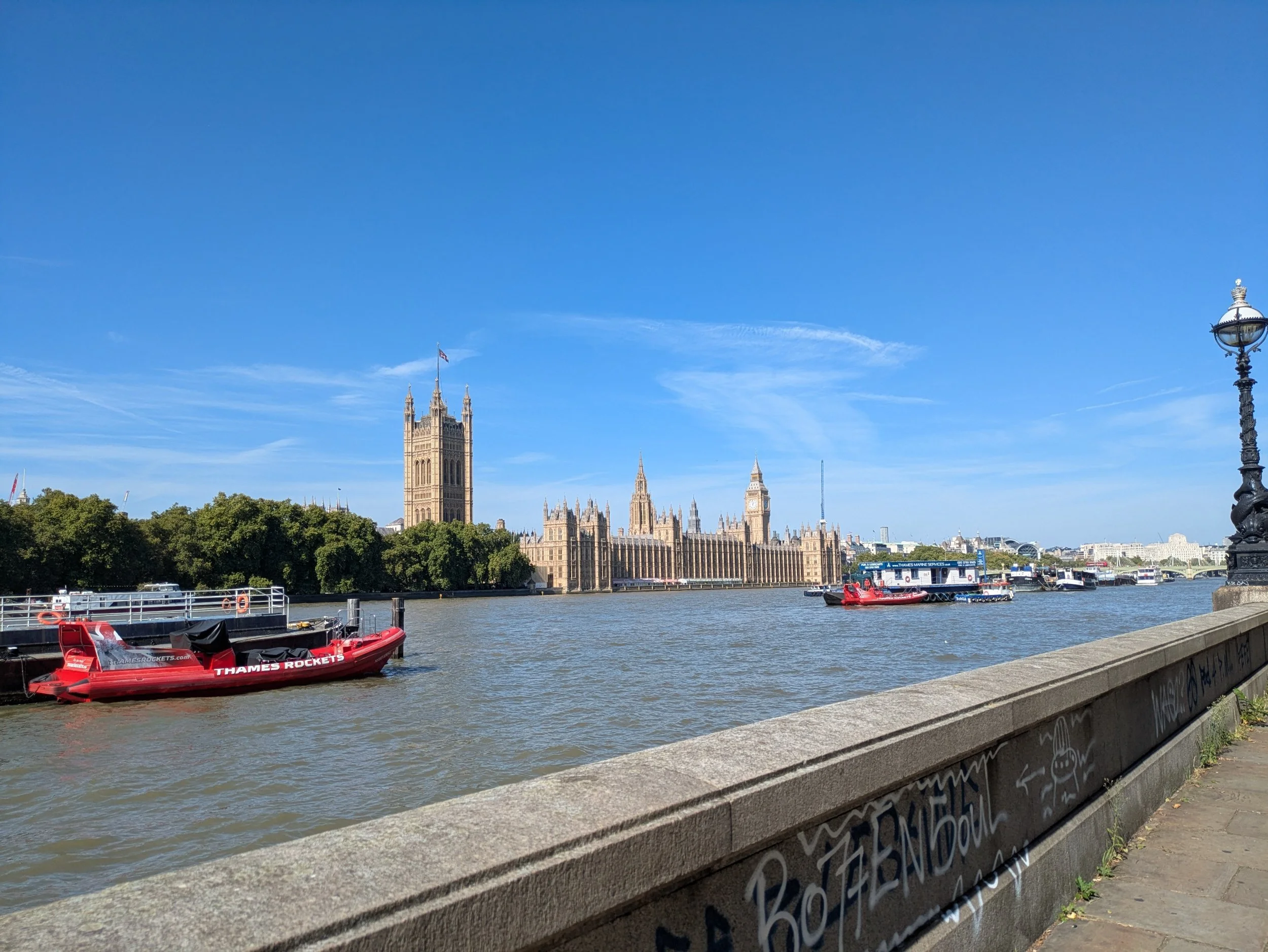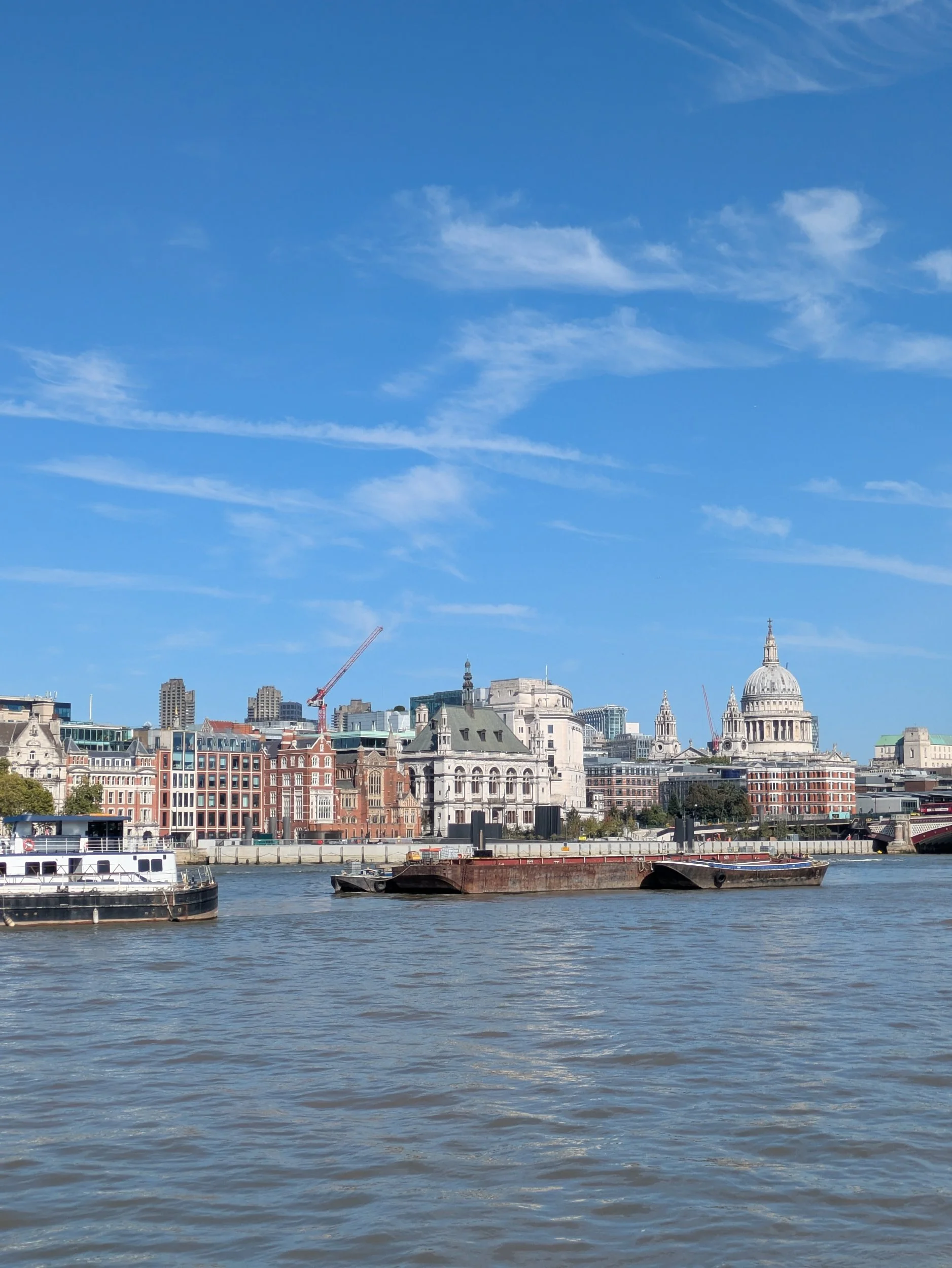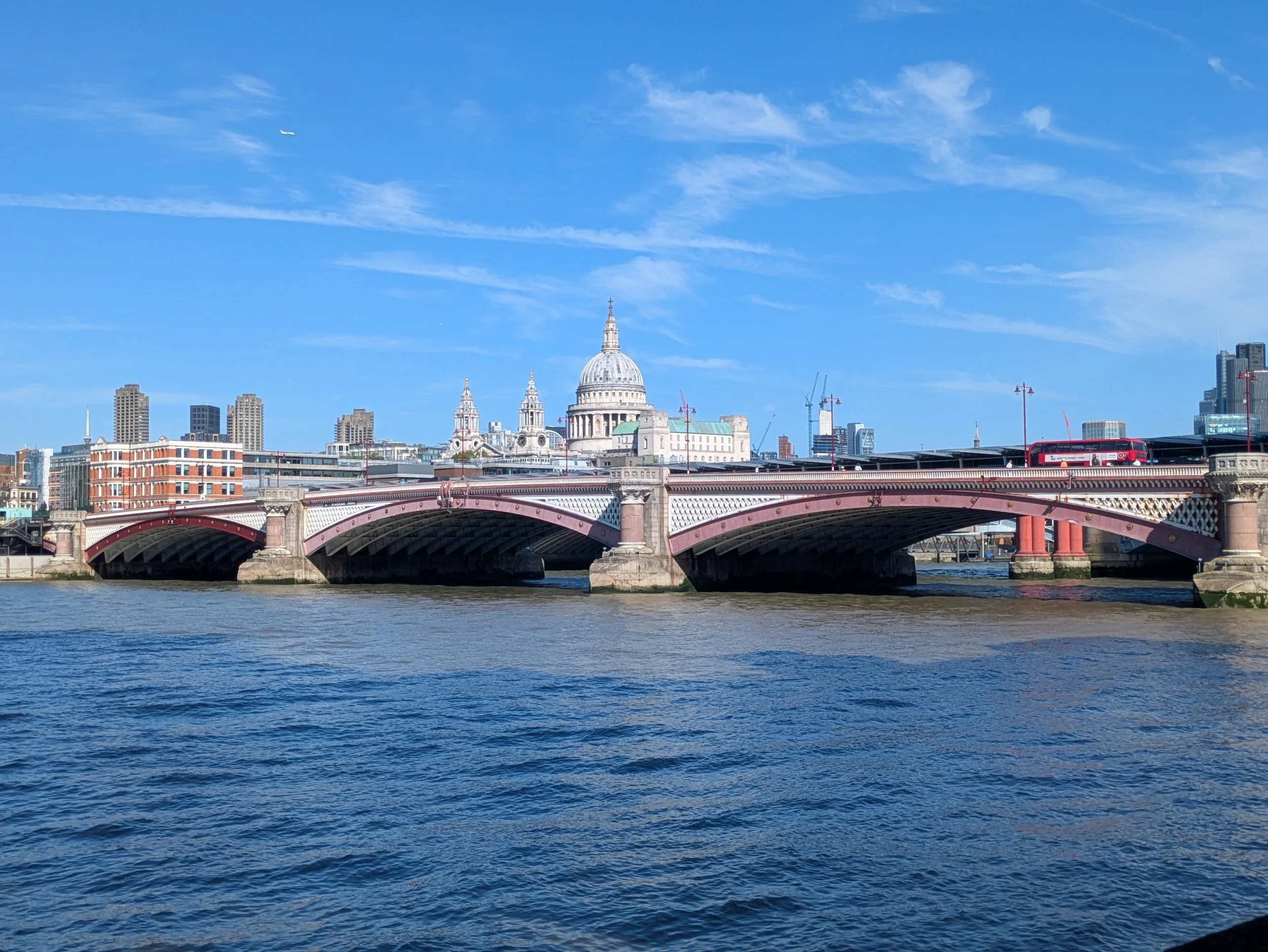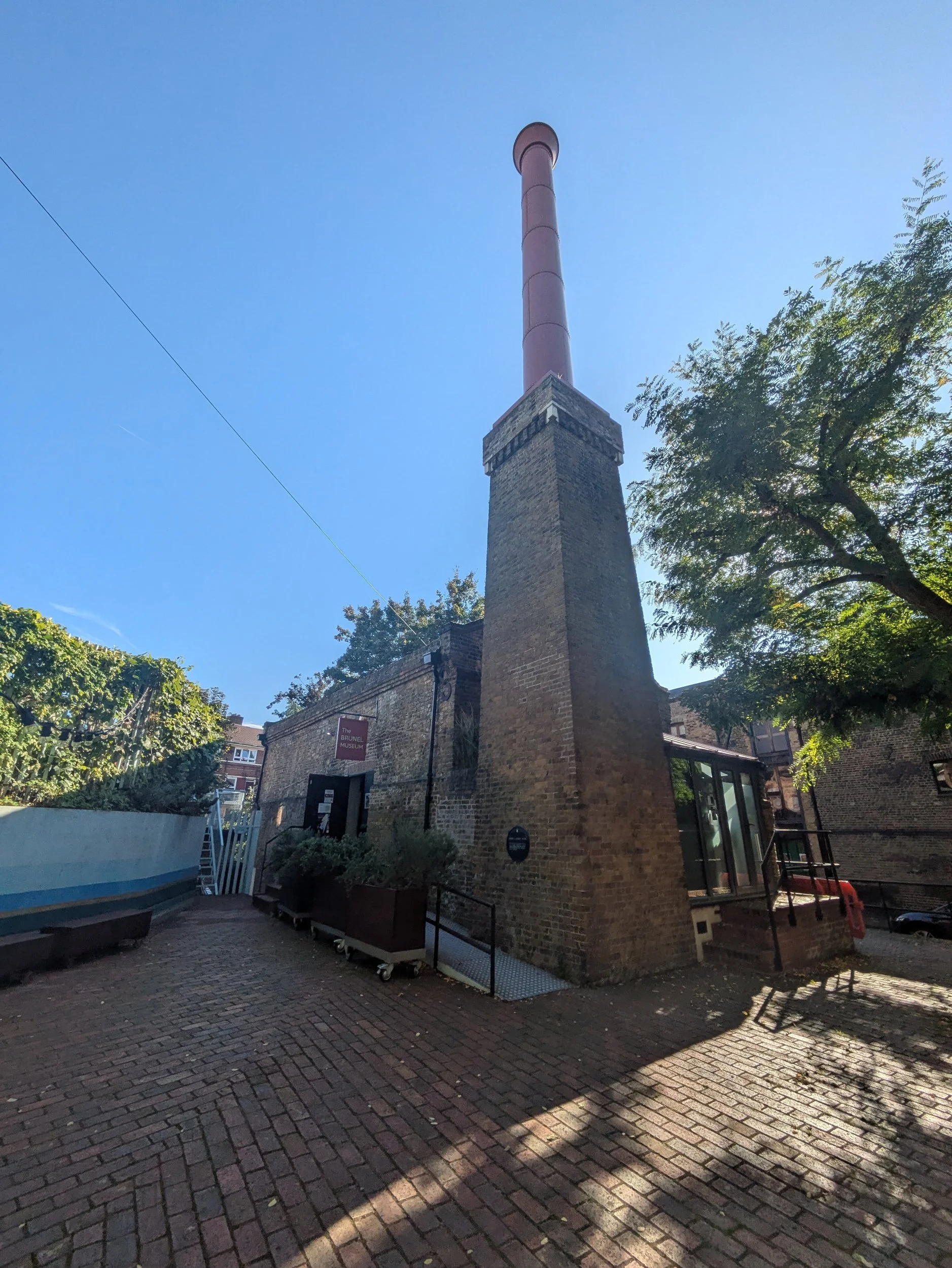Nordic Walking The Thames Path Leg 14: Putney Bridge to The Cutty Sark
Leg Fourteen: Putney Bridge to The Cutty Sark
When: Friday 19th September 2025
Miles Walked: Strava says 18.37, but it was more like 16
Steps Taken: 32,786
Moving Time: 5:09:28
Elevation Gain: 108ft
Today’s planned walk was 9.25 miles from Putney Bridge to Tower Bridge and so I left the campsite with Steve (he’s going to be a tourist today) and walked to Abbey Wood Tube station, it should take just over an hour to get back to Putney Bridge Tube Station to pick up where I left off yesterday.
After a slight delay and ending up crossing over the pedestrian part of Fulham Bridge I have to double back to Putney Bridge and stop en route at The Dynamo (a cyclists café) for a comfort break, a cuppa and a croissant (toilet stops are expensive in London!) The sun is shining and the forecast is for a warm and sunny day, I’m in my shorts and vest! Once back at the bridge the path goes around St Mary the Virgin Church back towards the river, there’s a café here too, if only we had known yesterday! It’s a nicely developed area with lots of benches to enjoy the riverside view.
After a stretch on the riverside the path heads along a residential street where I spot this semi-detached/terraced property that looks a bit strange, I wonder did it used to continue left? I love these old Riverside Walk signs as I head through Blade Mews (someone is having a new kitchen fitted!)
Beyond Blade Mews is Wandsworth Park, created in 1903 with its majestic avenue of over 120 year old London Plane trees which arch towards the river creating a green tunnel for me to walk through, pausing to look at various sculptures along the route. There’s also a double avenue of Lime Trees plenty of benches, mini golf, a bowling green and a café in the park and it is beautifully kept. This sculpture is entitled Pygmalion and is by Alan Thornhill.
On this stretch I start passing little houseboat flotillas, some of them are huge boats! The path moves away from the riverside again through what feels like a recently renewed area , a mix of residential flats and offices. A footbridge then takes me over Bell Lane Creek, one branch of the River Wandle and the route now goes around the Western Riverside Refuse and Recycling Centre, where non-recyclable waste is compacted and carried away in barges to be burnt to generate electricity. I’m approaching Wandsworth bridge, there’s been a bridge here since 1873, the present bridge, an unadorned steel cantilever bridge designed by Sir Thomas Peirson Frank, was opened in 1940. At the time of its opening it was painted in dull shades of blue as camouflage against air raids, a colour scheme it retains. It reminds me of the blue panels they had on Gorsemoor Middle School in Ferndown back in the 1980’s! There is much more of a cityscape beyond this bridge. I’venow reached Battersea Reach an development of residential apartment buildings that all look like ships. Completed in 2019 with over half of the 13 acre site landscaped public open space and over 300 metres of new riverside walk, which I am enjoying!
More houseboat communities on the river and more expensive looking apartment buildings across the river and I’m dodging cyclists in places! Battersea Railway bridge shades another few houseboats too. Completed in 1863 the bridge features five wrought iron arches, each spanning approximately 44 meters, and has a total length of approximately 387 meters. It is supported by brick piers faced with stone ashlar. The design includes riveted wrought iron segments, making it one of the earliest examples of a large railway bridge constructed primarily from wrought iron rather than cast iron A three-arch brick viaduct carries the line on the north side of the bridge, with one arch having been opened to provide a pedestrian route under the railway, as part of the Thames Path. On the south side are four arches, two of which are used as storage for the residents of a houseboat community moored immediately downstream, and another one of which was opened to Thames Path pedestrian traffic.
Across the river is a development known as Chelsea Harbour with it’s focal point being the 200ft Belvedere residential tower which acts as a sentinel for this 1980’s riverside village. It features a metallic pagoda-like roof and rows of metal balconies.
I’m in need of a comfort break and so am on the look-out for a café when I come across St Mary’s Church, a Georgian C of E Church open today as part of the Open House Festival. I pop in on the off-chance that they have a toilet, and they do! Once more in comfort I stop to chat to the two ladies welcoming visitors and tell them of my Thames Path Quest. This small church has a lot of history and is well worth a visit. You can have a look for yourself here. Our History - St Mary's Battersea and more about the building here Our Historic Building - St Mary's Battersea
I’m a big fan of sculpture and cities tend to have lots and London is no different, on Battersea Bridge Road I find this bronze of two parents holding their baby in the air, it’s missing a bird that originally was held by the child, but nonetheless still striking. Made by John Ravera in 1983 it is called In Town. Just a little further on is this swan, originally part of two, but I don’t remember there being another one. Another bronze from 1984 by Catharine Marr-Johnson, called Two Swans. Across the water is Crosby Moran Hall located next to the famous Cheyne Walk. Originally sited in Bishopsgate the hall was dismantled and rebuilt here in 1910, it’s a very fine example of Medieval architecture, but sadly is not open to the public.
I’m approaching a very fine suspension bridge which is Albert Bridge, reputedly the prettiest bridge in London. The Albert bridge opened in 1873 to designs originally drawn up by engineer Rowland Mason Ordish, it was a combination of a suspension bridge and a cable-stayed bridge, however, this design needed strengthening in 1884 — just 11 years after it originally opened. This was overseen by Sir Joseph Bazalgette (once again), who replaced the steel cables with steel link chains. In 1973, the bridge was strengthened further, this was done through the addition of two concrete piers underneath — so it became a beam bridge too. The bridge is currently painted pink, blue and green, in an attempt to increase visibility in fog and murky light and is lit at night with halogen bulbs to stop boats colliding with it. It looks great against the bright blue sky backdrop we have today. I’ve now reached Battersea Park, a 200 acre green space originally opened in 1858 by Queen Victoria. The park is home to a small children's zoo, a boating lake, a bandstand, and all-weather outdoor sporting facilities including tennis courts, a running track and football pitches. Four West London hockey teams use the all-weather Astroturf pitches. In the centre of the park is Pump House Gallery, which is housed in a four-storey Grade II listed Victorian tower. On the western side there are two cricket pitches. The park is the site of the London Peace Pagoda, erected in 1985. A Buddhist monk looks after the pagoda on a daily basis. In 2002–4 the park underwent a £11 million refurbishment funded in part by the Heritage Lottery Fund and was re-opened on 2 June 2004 by Prince Philip. It’s obviously a popular space as it is teeming with people.
I go underneath Chelsea Bridge, officially opened in on 6 May 1937 by the Prime Minister of Canada. Chelsea Bridge is 213m long, and 20m wide. It has three spans. I think it might be one of the most decorated bridges in London with five sets of lampposts, each decorated with golden galleons; and four tall turrets at either end of the bridge. These turrets are decorated with heraldic designs: a golden galleon on top, and, on the outside, the LCC coat of arms of an English lion, St George's Cross, and wavy lines representing the Thames. On the inward south side, there's the Battersea dove of peace; on the northwest corner there's the winged bull, lion, boars' and stag of the borough of Chelsea; on the northeast corner, there's the portcullis and Tudor roses of the borough of Westminster and the whole thing is painted white with a red trim and greyish blue balustrades.
Beyond Chelsea Bridge is Grosvenor Rail Bridge with the pumping station chimney clearly in view on the opposite side of the river and now I have reached the site of the former Battersea Power Station, From the 1930s to 1980s, Battersea Power Station was a working Power Station. At its peak, it was producing a fifth of London’s power, supplying electricity to some of London’s most recognisable landmarks, such as the Houses of Parliament and Buckingham Palace. In 2007 The Power Station was upgraded to Grade II* listed status to protect it for the future. Work began in 2013 to redevelop the 42-acre site surrounding the Power Station to create a new community of homes, shops, cafes, restaurants, cultural venues and open space for London. Did you know you can visit the top of one of the 109 metre chimneys for a 360 degree view of London? This area is also buzzing with people enjoying the sunshine! Here the Thames Path leaves the river for a bit and I get a bit lost around the Rocket Padel during a charity tournament and ended up on a service road, hilariously a chap says he is following me because I look like I know where I am going, he is walking on the Thames Path to Vauxhall today. Eventually following my nose I end up back by the river on the Thames Path!
What looks like icing nozzles all lined up on a wall are apparently an example of hostile architecture, these are anti-sitting studs designed to stop homeless people sleeping here or people sitting on this ledge or even skateboarders.
I’m now approaching Vauxhall Bridge, a riveted steel deck arch bridge. Visually, this bridge stands out from other bridges of this type because of its large and very detailed statues on the piers, the work of Alfred Drury RA and Frederick Pomeroy RA. It also stands out for its vibrant, contrasted paint, the bridge's ornamental design is unique in that it is decorated with female bronze figures on either side representing the functions of local government. Looking downstream, Drury's figures represent Government, Education, Fine Art and Science/Astronomy and facing upstream Pomeroy's represent Agriculture (holding a shepherd's crook and a sheaf of corn), Architecture (holding a model of St Paul's Cathedral), Engineering (holding a very detailed steam engine and mallet) and Pottery (holding a vase/pot). It was the first bridge to carry trams across the Thames. It is thought that there has been a bridge on, or very near, this site for as long as 3500 years.
I pass the MI6 building at Vauxhall Cross where there is a small circular colonnade in the style of a classical temple this sits on a new riverside space created by the Tideway London project, Isle of Effra and Effra Quay .feature wide paved areas and seating with gorgeous ornate lamposts. In the Albert Embankment Gardens sits a sculpture to Basaveshwara, unveiled in 2015. Basaveshwara was a 12th Century Indian Philosopher, pioneer of democracy and social reformer. He spread social awareness through his poetry and rejected gender or social discrimination, superstitions and rituals, he fought for freedom of speech, respect and tolerance. Sadly his attempts to abolish the discriminatory Caste system in India has never happened.
Across the road I spot some interesting benches and wooden arches. These were installed in 2009 to mark the location of the site of White Hart Dock, which can be traced back to the 14th century. The dock supplied nearby Doulton Pottery factories with clay right up until new clean air regulations came into force in 1956 and the pottery works transferred to Staffordshire. The beautifully ornate Southbank House, a 5-storey red brick building just down Black Prince Road is the former Royal Doulton offices, a listed building retaining many of its original features including decorative tiles and ornate finishes, it is the only remaining building from what was a huge site in the 1870’s.
Further along the road I pass this building with a ship poking out of its frontage! The building belongs to the International Maritime Organization and the ship is a memorial to those who have died at sea. The ship wasn’t there when the building was constructed in the early 1980’s, but was installed in 2001 and represents the bow of a cargo ship with a lone seafarer standing up on the front of the deck.
I’m now approaching Lambeth Bridge, the present bridge, opened in 1932, has five spans and is of steel construction, but there has been a crossing point here since the 1500’s. The Horseferry was used up until 1750 when Westminster Bridge opened. Lambeth finally got it’s own suspension bridge in 1862, but its condition deteriorated quickly and it had to be closed to vehicular traffic in 1910. World War 1 delayed construction of a new bridge, but finally got underway in 1924.
On this side of the river is Lambeth Palace, which stands on the opposite bank of the River Thames from the Palace of Westminster, has been the London residence of the Archbishops of Canterbury for almost 800 years. It has evolved over that period, with styles of architecture that range from medieval to 21st century. The palace has been the scene of various political and religious events of national importance.
The Houses of Parliament are looking resplendent in the autumnal sunshine. The first royal palace at the site of Westminster was built in around 1045 by Edward the Confessor, at the same time as Westminster Abbey, and throughout the medieval period functioned as the principle residence of England’s monarchs. The various administrative bodies of the day also met at Westminster during this time, including the Anglo-Saxon Witenagemot and the medieval Curia Regis, however it was in the 16th century that it became their permanent home. Following a fire in 1512 that destroyed the royal apartments, Henry VIII moved the royal family out of the Palace of Westminster and into the newly-purchased Palace of Whitehall, leaving his old residence to Parliament and the royal law courts.
Infamously the Houses of Parliament were also almost blown up by Guy Fawkes during the failed Gunpowder Plot of 1605. They survived however, until in 1834 the entire complex went up in flames, with only Westminster Hall, the Jewel Tower, Cloisters, Undercroft Chapel, and Chapter House of St Stephens surviving. Following which the Houses of Parliament were rebuilt by Sir Charles Barry and Augustus Pugin in the magnificent form they remain today. The iconic clock tower largely known as ‘Big Ben‘ was built during this time, and has swiftly become one of London’s most recognisable symbols. Today the Houses of Parliament remain the seat of the UK Parliament who conduct regular sessions there.
I also walk past the sobering sight of the National Covid Memorial Wall, created in 2021 as a visual representation of the UK's catastrophic loss to Covid-19. The Wall stretches for 500 metres alongside the River Thames, directly opposite the Houses of Parliament. There are more than 240,000 individually hand-painted red hearts, each representing a person who died in the UK with Covid-19 as a direct cause of death. Many of the hearts on the Wall have been personalised with individual messages written either by the bereaved or by the volunteers who are there every week, maintaining this unique memorial. The original hearts were drawn with art pens, which have faded with the London weather, so each heart on the entire Wall has been repainted with long-lasting masonry paint by the Friends of the Wall team. They continue to add new hearts for those who are still dying from the Covid-19 virus.
The first Westminster Bridge was built between 1739-1750 by Swiss architect Charles Labelye, making it one of the oldest bridges across River Thames in central London. It was a much-needed connection point between Westminster on the west bank and Lambeth on the east bank. However, due to structural issues over time, it had to be replaced. The present-day stone bridge we see today was designed by Thomas Page and opened on May 24th 1862 – Queen Victoria’s birthday – symbolising yet another milestone in Victorian engineering prowess. With seven arches spanning over 250 meters, this Gothic-styled bridge quickly became an integral part of everyday life in London.
I meet Steve in a little cafe just off Westminster Bridge for an expensive sandwich, I’m pretty sure this used to be a Pret, annoyingly no toilet! After our lunch we carry on walking down the Queen’s Walk past the Paddington Bear experience and I leave him outside the Shrek’s Adventure and carry on towards the London Eye. At an overall height of 135 metres, the London Eye originated as an entry in 1993 to a competition for a new landmark to commemorate the millennium in London. Construction began in 1998, and the wheel was put together over the river, in a horizontal position, before being pulled upright. It was ceremonially opened by Prime Minister Tony Blair on December 31, 1999. Originally scheduled to be dismantled after five years, it was kept in place because of continued popularity. The wheel itself has a diameter of 120 metres and is connected to its hub by 64 cables that function much like the spokes of a bicycle wheel. Mounted on the wheel are 32 ovoid cabins that carry the passengers, their number corresponds to the 32 boroughs that constitute Greater London. Each capsule has a capacity of 25 passengers and rests on motorized mounts that function in such a way that the capsule remains upright as the wheel turns. The wheel moves so slowly—two revolutions per hour—that it need not stop for boarding or disembarkation of passengers.
It is busy on the South Bank on this warm September Friday, it’s almost impossible to Nordic walk through the crowds and I end up just carrying my poles on this stretch. Now on Jubilee Walk (1977) I pass the National Theatre with a statue commemorating the actor Laurence Olivier, the yellow steps of the Southbank Centre with a heavily graffitied skate park underneath, a living statue drawing a crowd, an old fashioned horse carousel in full swing and an area of huts (bit like a Christmas market) where I stop to look at earrings and buy myself a pair. The sculpture is called Jubilee Oracle by Alexander (1980), there’s a big crowd watching a man squeezing himself into an impossibly small box too, weird!
Outside the National Theatre there is another sculpture, originally created for the Festival of Britain in 1951, a bronze cast of the original plaster sculpture by Frank Dobson entitled ‘London Pride’ Placed here in 1987.
I can now see Blackfriars Bridge ahead. The present bridge which on 6 November 1869 was opened by Queen Victoria is 281 m long, consisting of five wrought iron arches built to a design by Joseph Cubitt. Cubitt also designed the adjacent rail bridge (now demolished) and it was a condition that the spans and piers of the two bridges be aligned. They have left the red pillars of the old rail bridge in the river as well as this highly decorative London, Chatham, and Dover Railway sign. Across the river I can see St Paul’s and lots of London’s landmark skyscrapers.
This is probably one of the most well-known stretches of the River Thames in London, I’m now passing Tate Modern, The Globe Theatre and The Millennium Bridge which is a steel suspension bridge for pedestrians crossing the River Thames. Construction began in 1998, and it initially opened on 10 June 2000. Londoners nicknamed it the "Wobbly Bridge" and even the "Wibbly Wobbly" after pedestrians experienced an alarming swaying motion on its opening day. The bridge was closed later that day and, after two days of limited access, it was closed again for almost two years so that modifications and repairs could be made to keep the bridge stable and stop the swaying motion. It reopened in February 2002,
I pass a harpist in a subway as the Thames Path passes the ruins of Winchester Palace, from the street you can see the remains of the great hall of Winchester Palace, built in the early 13th century as the London house of the Bishops of Winchester. The remains include the striking rose window which adorns the west gable. Most of the palace was destroyed by fire in 1814.
The Thames Path passes by The Golden Hinde, a full-size reconstruction of the famous Elizabethan galleon, captained by Sir Francis Drake, the first English ship to circumnavigate the globe. I pop into the shop at Southwark Cathedral to get a stamp for my Thames Path Passport and on my way to Queen’s Walk pass this interesting mosaic. a figure of ‘St Olave, King of Norway’ in black and gold, also by Frank Dobson, this art-deco building used by a hospital stands on the site of St Olave’s Church. Here the Thames Path follows The Queen’s Walk passing Hays Galleria, originally Hay’s Wharf, established in the 17th century. The site was originally purchased by Alexander Hay in 1651, who repurposed it from a brewhouse into a pipe-boring and shipping yard, it has transformed into a vibrant destination featuring retail shops, restaurants, public art, and offices, it has an impressive glass roof!
Passing HMS Belfast, now 9 floors of ship to visit and explore! In May 1971 after 32 years of service during which she had steamed over half a million miles she was destined for the scrap yard, but help was at hand, as the Imperial War Museum had been looking into preserving a second world war Cruise, a Trust was formed by one of HMS Belfast former Captains, now Rear Admiral Sir Morgan Morgan-Giles. who succeeded in bringing her to London where she opened up to visitors on Trafalgar Day 21st October 1971.
I can now clearly see Tower Bridge approaching, such a landmark on the River Thames, I ran over it when I ran The London Marathon in 2014! Tower Bridge was completed in 1894, it’s known for its unique bascule design and you can have a tour transporting you to Victorian London, telling the story of the city’s defining landmark from the very beginning. You can also watch city life unfold in panorama from its high-level Walkway and Glass Floor. There are lots of people stopping to take selfie’s with the bridge, myself included! On the opposite bank proudly stands the Tower of London, The Tower of London was built in the 1070s by William the Conqueror. As protector of the Crown Jewels, home of the Yeomen Warders and its legendary guardians, the ravens, the Tower now attracts over three million visitors a year. Throughout history, the Tower has also been a visible symbol of awe and fear. Kings and queens imprisoned their rivals and enemies within its walls. As the most secure castle in the land, the Tower guarded royal possessions and even the royal family in times of war and rebellion. But for 500 years monarchs also used the Tower as a surprisingly luxurious palace.
Beyond Tower Bridge the crowds dissipate and it feels much more peaceful beside the river. I pass through St Saviour’s Dock an area notorious for pirates in the 18th century. Stranded cargoes were vulnerable to attack and if caught the pirates were hung at the mouth of this dock. I cross over a hydraulic cable stay swing bridge installed in 1995 to connect up the Thames Path. There are some impressive apartment blocks along here including New Concordia Wharf, originally a cornmill and warehouse.
Around the corner I happen upon a group of sculptures known as ‘Dr Salter’s Daydream’. Ada and Alfred Salter were legendary and beloved in Bermondsey, their lives were marred by a great personal tragedy, in 1910 their only child, Joyce, aged 8, died from scarlet fever. This is the story the sculptor Diane Gorvin reflects on in this ensemble. In his old age Alfred sits imagining Ada, Joyce and her cat as they once were, in happier days long gone by. You can read more about their fascinating story here. Dr Salter's Daydream: A Moving Set Of Statues In Bermondsey - Living London History
This next stretch is full of charm and interesting bits and bobs, starting with the Grade II listed The Angel Rotherhithe an early 19th century pub and round the corner in King’s Stair Gardens there’s a memorial celebrating Queen Elizabeth II’s Golden Jubilee, unveiled in 2002. Rotherhithe Street has balconies across the street and was once the thoroughfare of a centre of a major shipbuilding, apparently it’s the longest street in London.
There’s a beautiful church in Rotherhithe, St Mary’s Church. Christians have worshipped on this site for at least 1000 years. The present parish church, replacing a 12th century building, was completed in 1716. Designed by John James, an associate of Sir Christopher Wren, it has a homely grandeur with deep roots in the maritime history of Britain. The links with the ‘Mayflower’, with the Pilgrim Fathers, and with Prince Lee Boo of Pelau, are particularly treasured. I stop at The Mayflower Pub to get another stamp in my passport and use their facilities, it’s the oldest pub on the River Thames in London. It is a traditional English pub surrounded by cobbled streets, the outside decked jetty and cosy candlelit restaurant have stunning river views. At low tide you can spot the original 1620 mooring point of the Pilgrim Father’s Mayflower ship.
Across the way from The Mayflower Pub is The Brunel Museum, which is an educational charity and tells the story of one of the world’s great engineering dynasties. Brunel organised the world’s first underground concert party here in 1827, and the Museum celebrates and interprets music and theatre as well as engineering. I pop in to pick up another stamp and a cold drink as it’s still really warm! The Mayflower roots are strong here and around another corner there is Cumberland Wharf, a small park with circular seating areas and plenty of trees. Below is Rotherhithe Beach. In the corner is a statue of a boy dressed in 1930s attire, his dog and a pilgrim father. This makes sense, as it is close to this spot that the Mayflower set sail for Southampton, on September 16, 1620, before heading to the New World. The statue depicts the ghost of a Pilgrim Father, William Bradford, then Governor of the New Plymouth Colony, looking in horror over the boy's shoulder at what has happened within the New World, since his death. Peter McLean is a local artist who was commissioned to create the piece in 1991, by the London Dockland Development Corporation.
The shiny red bridge is a Scherzer bascule bridge, no longer operational and it is truly massive! As I am walking next to the river I can enjoy the river traffic as well as the street scenery. A Union Jack speedboat has just sped past! There was also a group of guys in sea kayaks out for a slightly more serene paddle!
I’m enjoying this stretch of the Jubilee Greenway, a 60km long route linking all of the major London 2012 Olympic sites, and marking the Diamond Jubilee of Queen Elizabeth II. I love all the converted warehouses along here too. Globe Wharf (red windows) was once a rice warehouse and was built over 160 years ago. The Thames Path weaves in and around these old warehouses and where newer houses have been built there are gorgeous tree-lined streets for me to walk through. I can see Canary Wharf in the distance on the opposite bank.
I come across a large stone obelisk at Pageant’s Wharf. It is square and pointed at the top, standing in front of modern housing, there is no inscription on the obelisk and there is no explanatory plaque nearby. A mystery that needs further research! Unfortunately, the story isn’t particularly interesting. The master-plan for Canary Wharf Estate – on the Isle of Dogs – was laid out on a symmetrical axis, running through Canary Wharf Tower. If the line of that axis is extended westwards, across the Thames, it passes through the point where the stone obelisk stands. Pageant Stairs are modern concrete steps on the site of the old river stairs, named after a site on the east side with the name Pageant’s Wharf that was in use until the 1970s. Barratt Homes built the steps as part of their housing development Pageant Crescent in the 1990’s.
I have now reached Surrey Docks Farm, a working city farm and charity that enables the whole community to learn about farming, food production and the natural environment, they run a range of educational projects targeted to engage those who would benefit most. Here there is a café - The Barn and I pop my head around the half shut door to discover they have literally just closed, however the staff take pity on me and let me buy an ice-cream! I’ve never had a Black Coconut ice-cream before and wonder two things as I eat it, what makes it black and will it turn my mouth black? So I discover the black is added ash (weird) and I don’t think it did turn my mouth black. It was delicious by the way, I sat on a bench by the animal sculptures overlooking the Thames in the late afternoon sunshine! The animal sculptures commemorate the Farms relocation in 1986, when the animals were herded from the first site at Greenland Dock and led along the river to their new permeant home.
In Helsinki Square I pause to ponder this unusual sculpture, ‘Curlicue’ by William Pye. A steel tubular structure placed here in 1989.
The sun is shining over the moored boats in Greenland Dock, an eclectic mix of boats reside within the oldest wet dock in London. I pass this steel sculpture, mounted on a dolphin (the mooring structure underneath) on the end of some of the rods are red disks which form lines around the globular structure marking out the route of Sir Francis Drake’s circumnavigation voyage in 1577-1580. Stephen Lewis and Chris Marshall created this in 1998. Further on as I walk towards Deptford I pass several cannons and a National Cycle Network marker telling me it is 110 miles to Oxford and 115 miles to Dover. The Thames Path leaves the riverside for a bit now. I pass through a park where there is an energetic game of basketball on the multi-court and several dog walkers stretching their pooches legs.
Passing through the courtyard of the popular Dog & Bell Pub with this great Guinness mural painted on its side, it’s busy with punters enjoying the warm late afternoon sunshine. It is now just 3/4 of a mile to Greenwich which is coming as a relief to be honest! After walking through Twinkle Park with a lovely wildlife pond and leaving by the wrong exit, retracing my steps to find the correct one (not really sure if I was meant to walk through there at all). I pass by a very grand looking tableaux sculpture featuring Peter the Great, this was unveiled in 2001 and commemorates the Tsars visit to Deptford in 1698. Created by Mihail Chemiakin, it was gift from Russia. Back on the riverside once more I can now see The Cutty Sark in the distance, not far now!
It’s weird to think that the River Thames is tidal, I pass an area of the river that is clearly displaying currents and waves are lapping on the wall. I pass by another very ship like apartment block and turn the corner to see the Cutty Sark in all her glory, I am not unfamiliar with this area and have visited the Cutty Sark a few years ago now. I’m meeting Steve here somewhere hopefully. It is buzzing with people and there is a street food market and a street entertainer singing away. I spot Steve sitting on a wall. Phew that was a long, but very enjoyable day! There is just shy of 6 miles left to Nordic Walk tomorrow. Steve and I get a cheeky Chippy Tea from a chip shop in Greenwich before heading back to Abbey Wood to the campsite together.













